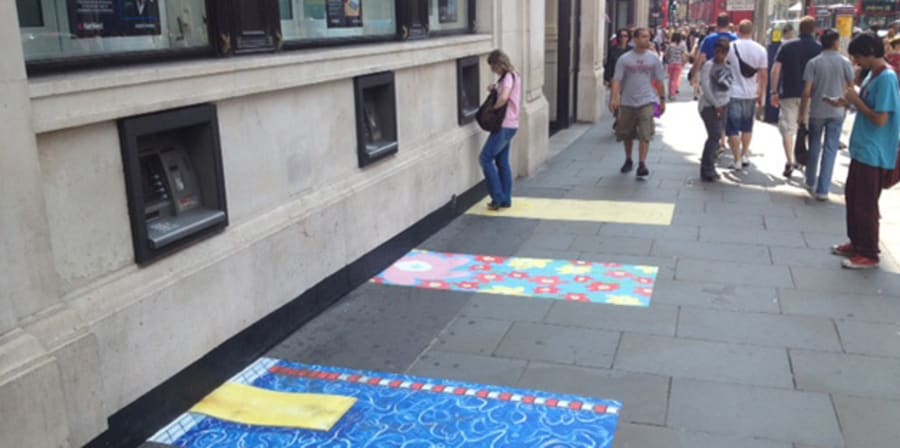
In 2007, Greater Manchester Police reported that one in four street crime offences (personal robbery and snatch theft) happened near ATMs. Also, that on introducing yellow lines demarking ‘privacy’ or ‘safety’ zones on pavements at ATMs these crimes appeared to be reduced by 66% within 150 meters of the ATM.
“I was aware that raising awareness amongst the public could sometimes be seen in a negative way within the local business community…What we wanted to achieve were designs, which would be seen as positive, innovative and create a talking point.
Paul Truman, Hammersmith Police
Despite the increased security offered by these ‘safety zones’ there is little enthusiasm amongst banks, businesses, or those that use and manage our streets for this strategy. Whilst the boxes provide a ‘defensible space’ that customers can point to when requesting privacy, the yellow lines used are more commonly associated with instructing vehicles rather than people. Their appearance detracts from the appeal of our high streets and may even contribute to ‘fear of crime’ amongst bank customers and the wider public by signalling insecurity.
In 2010, a collaboration between Hammersmith Police, National Westminster Bank/RBS and the Design Against Crime Research Centre trialled a new approach to creating defensible space for ATM customers. Artworks were introduced in place of yellow boxes. The results were promising. The ATM Art appealed to customers, businesses and the wider public and crime problems associated with proximity to ATM customers, including distraction theft, shoulder surfing and pickpocketing appeared to be reduced.
Building on this success, Royal Bank of Scotland, Customer Outcomes Team (COT) initiated a multi-agency programme to rigorously trial ATM Art to explore its potential for improving customer service and security. Working in partnership with the Design Against Crime Research Centre at CSM, Metropolitan Police (Camden), Metropolitan Police (Westminster), City of Westminster and London Borough of Camden and the Jill Dando Institute of Crime Science, University of Central London. RBS COT oversaw the design and delivery of a control trial of ATM Art mats in London Borough of Camden and City of Westminster between July 2011 and July 2013.
The trial tested the impact of ATM Art on the behaviours of ATM users and other users of the streetscape in relation to customer security and customer experience, so as be able to base any future recommendations regarding installation of ATM Art on robust evidence.
The trial concluded that ATM Art is considered to contribute positively to community safety and the streetscape. Specifically, ATM Art was found to contribute positively to customer experience and security in that it:
- Increased privacy for ATM users
- Increased secure behaviours amongst ATM users
- Made ATM users feel more secure
- Had a small positive effect on transaction volumes at ATMs where ATM
Concerningly, research also found that more than 90% of ATM users surveyed during the trail had at some stage felt the need to ask other users of the streetscape to grant them more privacy when using an ATM. Of, these less than half had felt able to do so, suggesting more needs to be done to make more people aware of their right to privacy when using an ATM, and the public in general more considerate of granting space to ATM users.
The ‘Your Space’ project responds to this challenge by engaging local people in the creation of ATM Art. This process uses the creation of artworks as a means to raise awareness for ATM security (and the right to privacy) whilst also affording greater local ownership of, and pride in, the public realm for ‘ATM Artists’ and their Communities.
Background:
- ATMs have been in use for over 40 years
- £185.7bn was withdrawn from UK ATMs in 2010
- There are 63,000 ATMs in the UK (2010), and nearly half our cash requirements are now obtained from ATMs
- 6.4% of plastic card users were reported victims of fraud during 2009-10
- ATM crime is a world-wide issue.